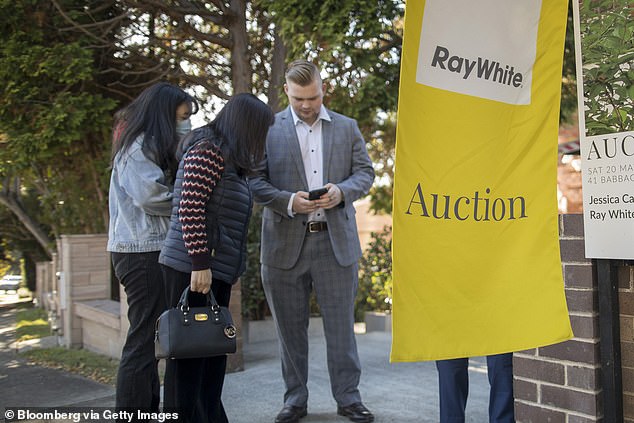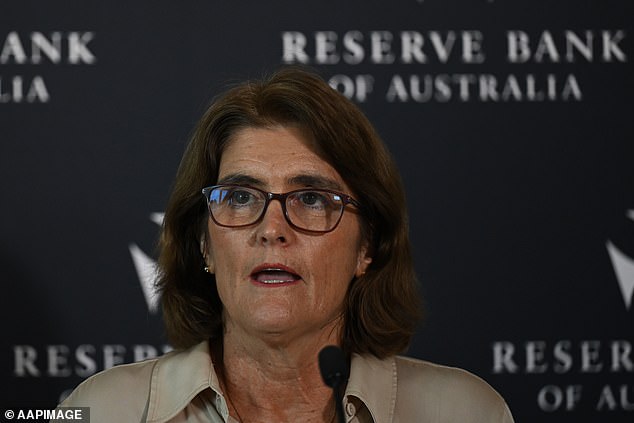The Reserve Bank has issued a chilling warning to all Australian borrowers hoping for mortgage rate relief in the coming months.
The cash interest rate remained unchanged Tuesday afternoon at 4.35 percent, its highest level in 12 years, but Governor Michele Bullock warned that further rate hikes were still possible, which would bring a new blow to those who expected a rate cut in the near future.
“The interest rate path that will best ensure that inflation returns to its target within a reasonable time frame remains uncertain, and the board is not ruling anything out,” she said.
“Returning inflation to its target within a reasonable time frame remains the board’s top priority.”
Ms Bullock doubled down on her inflation warning at a press conference as 3.8 million households with mortgages struggle with a cost of living crisis.
“The war is not yet won, so we remain vigilant and we cannot exclude anything or exclude anything,” she said.
“We are not confident enough to rule out further interest rate changes.
“The possibility of a rate hike is something the board might consider by asking, ‘Well, are we in the right place?’

The Reserve Bank has issued a chilling warning to all Australian borrowers (pictured: an auction in Sydney)
Big banks and economists had expected rate cuts in 2024 as inflation moderated.
But Ms Bullock said inflation remained too high, even though interest rates were kept unchanged for the RBA’s third meeting in a row.
“Even though recent data indicates that inflation is slowing, it remains high,” she said.
“The board expects that it will take some time before inflation returns sustainably to the target range.”
Ms Bullock said the conditions for a rate cut were not yet ripe before monetary policy could be eased for the first time since November 2020.
“What we need to look at in cutting rates is actually being much more confident that inflation will come back into range in the future,” she said.
“If we were to see some acceleration and have more confidence in our results, then possible rate cuts could be on the agenda, but at the moment we don’t see that.
“We are in a position where we are cautious, we want to wait and see. As I said, there are risks on both sides.
Monthly inflation data showed the consumer price index at 3.4 per cent in January, which is just above the RBA’s 2-3 per cent target.
But the more comprehensive quarterly CPI data shows annual headline inflation of 4.1 percent in December.
The Reserve Bank does not expect inflation to fall within its target range of 2 to 3 percent until December 2025.


The cash interest rate remained unchanged Tuesday afternoon at 4.35 percent, its highest level in 12 years, but Governor Michele Bullock warned that further rate hikes were possible – dealing another blow hard on those who were hoping for an upcoming rate cut.
Ms Bullock warned that inflation could remain high unless workplace productivity improves to justify faster wage growth.
Australia’s hourly productivity levels fell last year by 0.4 percent – a far cry from long-term average levels above 2 percent.
“Nevertheless, this level of wage growth remains consistent with the inflation target only under the assumption that productivity growth approaches its long-term average,” she said.
The RBA’s 13 rate hikes in 18 months, between May 2022 and November 2023, marked the most aggressive pace of monetary policy tightening since 1989.
A borrower with an average mortgage of $615,178 now pays $16,728 more per year in repayments, compared to May 2022, when the RBA cash rate was still at a record low of 0.1%.
The rate hikes slowed the economy, with gross domestic product growing just 0.2 percent in the December quarter.
Australia’s annual growth rate of 1.5 percent in 2023 was almost half of the 2022 level of 2.7 percent.
“While there are encouraging signs that inflation is moderating, the economic outlook remains uncertain,” Ms. Bullock said.
“National accounts data for the December quarter confirmed that growth has slowed.”
Australia has not experienced a recession since the 2020 lockdowns, but it has been in a per capita recession since the March quarter last year, where output per worker declined.
Gareth Aird, head of Australian economics at the Commonwealth Bank, noted that the RBA’s language had softened with the ‘T’ phraseThe board of directors does not decide anything positive or negative.
“The board has moved from a slight tightening to a neutral focus,” he said.
Ms. Bullock admitted Tuesday: “We changed the language, yes, but it was in response to some data that demonstrated to us that we are still very much on the path we thought we were on.”


Ms Bullock warned inflation could remain high unless workplace productivity improves to justify faster wage growth (pictured, a Sydney waitress).
Stephen Smith, partner at Deloitte Access Economics, said the Reserve Bank should cut rates in September to stimulate the economy amid a slowdown.
“Slow economic growth and a rise in the unemployment rate, partly offset by support for tax cuts from July 1, as well as a deceleration in inflation, mean that there will be a need to move from controlling from inflation to boosting growth in 2024,” he said.
The RBA now meets eight times a year instead of on the first Tuesday of each month, except January.
Ms Bullock is currently holding a press conference, following a two-day board meeting on monetary policy.
The next meeting of the Reserve Bank’s board of directors will take place on May 6 and 7.
